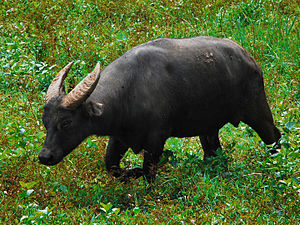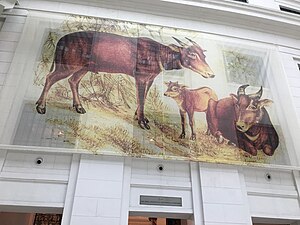Tamaraw

The Tamaraw or Mindoro dwarf buffalo (Bubalus mindorensis) is a small buffalo belonging to the family Bovidae.[1] It is endemic to the island of Mindoro in the Philippines, and is the only endemic Philippine bovine. It is believed, however, to have once also thrived on the larger island of Luzon. The tamaraw was originally found all over Mindoro, from sea level up to the mountains (2000 m above sea level), but because of human habitation, hunting, and logging, it is now restricted to only a few remote grassy plains and is now a critically endangered species.[2]


Contrary to common belief and past classification, the tamaraw is not a subspecies of the water buffalo, nor is it a subspecies of the slightly larger carabao, which is classified as a subspecies of the water buffalo. In contrast to the carabao, the tamaraw has a number of distinguishing characteristics; it is slightly hairier, has light markings on its face, is not gregarious, and has shorter horns that are somewhat V-shaped.[3] It is the second-largest native terrestrial mammal in the country next only to the Carabao.
In Philippine culture[edit]

Though the national animal of the Philippines is the carabao,[4] the tamaraw is also considered a national symbol of the Philippines. An image of the animal is featured on a Flora and Fauna Series 1 peso coin released from 1983 to 1994.[5]
In 2004, Proclamation No. 692 was enacted to make October 1 a special working holiday in the province of Occidental Mindoro. In line with the Tamaraw Conservation Month, the proclamation aimed to remind the people of Mindoro the importance of the conservation of the tamaraw and its environment.[6]
During the wake of the Asian utility popularity in the 1990s, Toyota Motors Philippines released the Toyota Kijang as the Tamaraw FX, an evolution of the Tamaraw AUV. It was widely patronized by taxi operators, and was immediately turned into a staple mode of transportation much like a cross of the taxi and the jeepney. The FX later saw a new generation model known locally as the Revo[7] The tamaraw is also the mascot of the varsity teams of the Far Eastern University (FEU Tamaraws) in the University Athletic Association of the Philippines, and of the Toyota Tamaraws of the Philippine Basketball Association.[8] The Tamaraw Falls in Barangay Villaflor, Puerto Galera, were also named after the bovine.[9]
References[edit]
- ↑ "Bubalus mindorensis". Integrated Taxonomic Information System. Retrieved March 17, 2007.
- ↑ Cite error: Invalid
<ref>tag; no text was provided for refs namediucn status 13 November 2021 - ↑ Fuentes, Art (February 21, 2005). "The Tamaraw: Mindoro's endangered treasure". Haribon. Haribon Foundation for the Conservation of Natural Resources. Retrieved March 17, 2007.
- ↑ "Philippines Independence Day Celebrations". National Symbol. 123independenceday.com. Retrieved March 29, 2007.
- ↑ Breithaupt, Jan (April 29, 2003). "Bubalus mindorensis, Philippines". EcoPort Picture Databank. EcoPort. Retrieved March 29, 2007.
- ↑ "Proclamation No. 692" (Press release). Government of the Republic of the Philippines. August 13, 2004. Archived from the original on August 3, 2007. Retrieved July 28, 2007. Unknown parameter
|url-status=ignored (help) - ↑ "Overall Chronological Table: 1971-1980". 75 Years of Toyota. Toyota Motor Corporation. Retrieved January 18, 2014.
- ↑ "FEU Diliman". feudiliman.edu.ph. Retrieved March 1, 2022.
- ↑ "10 awesome Boracay alternatives". April 4, 2018.
Bibliography[edit]
- "Bubalus mindorensis". Integrated Taxonomic Information System. Retrieved March 17, 2007.
- Callo, R. A. (1991). "The tamaraw population: decreasing or increasing?". Canopy International. 16 (4): 4–9.
- Custodio, Carlo C.; Myrissa V. Lepiten; Lawrence R. Heaney (May 17, 1996). "Bubalus mindorensis". Mammalian Species. American Society of Mammalogists (520): 1–5. doi:10.2307/3504276. JSTOR 3504276.
- Gesch, P. (2004). "Bubalus mindorensis". Animal Diversity Web. University of Michigan Museum of Zoology. Retrieved March 17, 2007.
- Heaney, L. R.; J. C. Regalado Jr. (1998). Vanishing treasures of the Philippine rain forest. Chicago, Illinois: Field Museum, Chicago. ISBN 9780914868194. Search this book on

- Momongan, V. G.; G. I. Walde (1993). "Behavior of the endangered tamaraw (Bubalus mindorensis huede) in captivity". Asia Life Sciences. 2 (2): 241–350.
- Bittel, Jason (May 21, 2019). "The Philippines Is Rallying Behind Its Disappearing Dwarf Buffalo". Earth Island Journal.
External links[edit]
| Wikispecies has information related to Bubalus mindorensis |
Lua error in Module:Taxonbar at line 146: attempt to index field 'wikibase' (a nil value).
